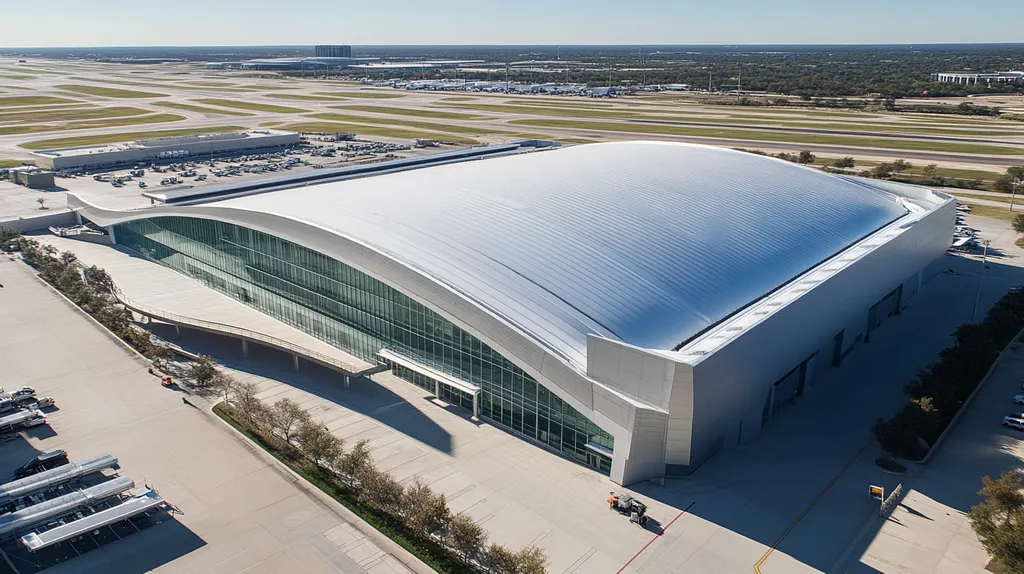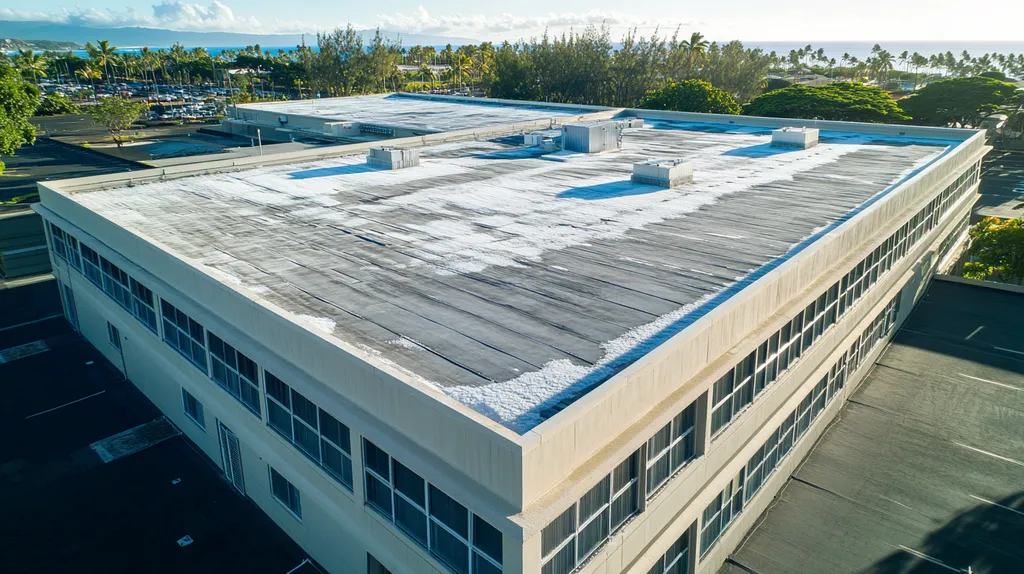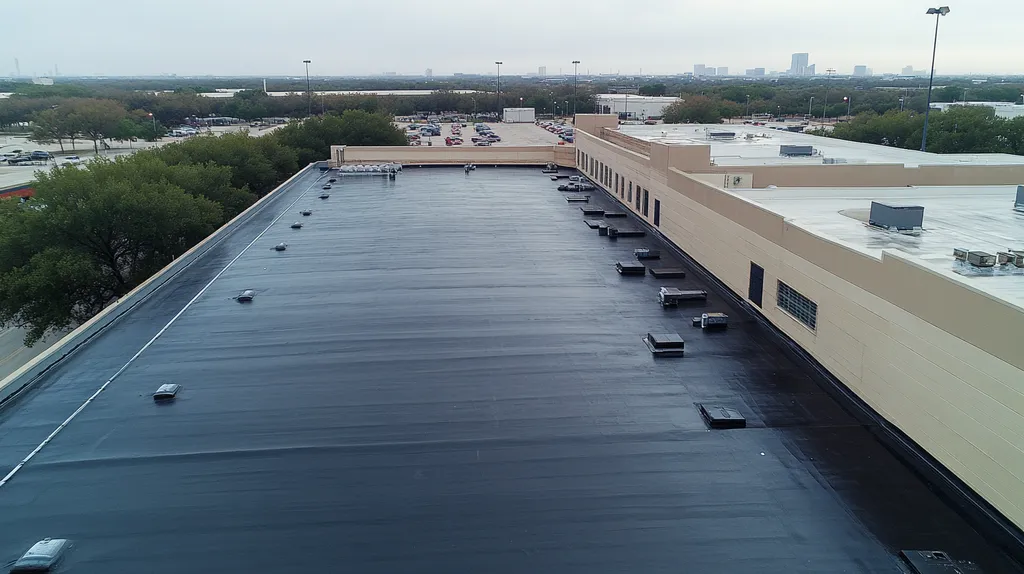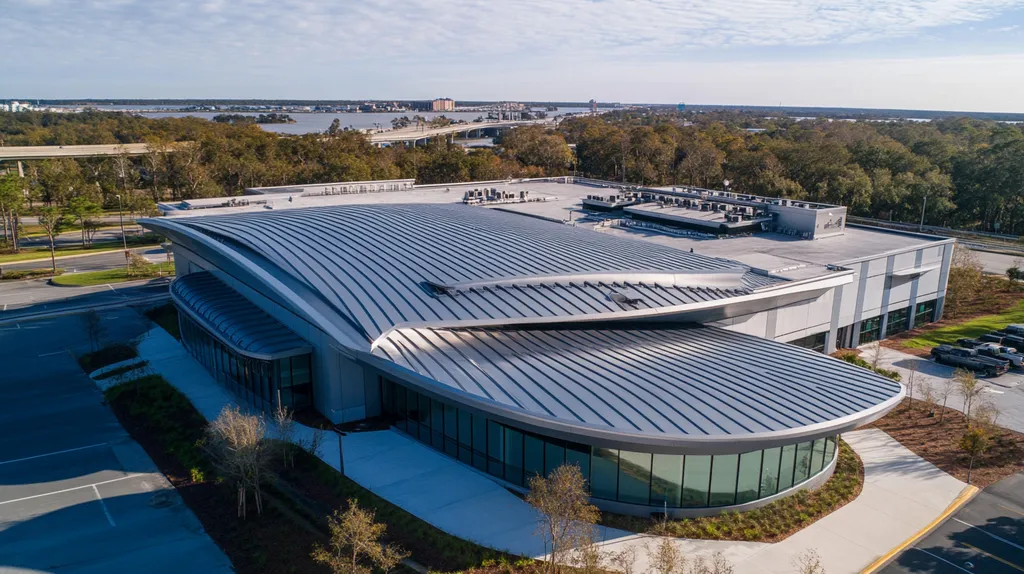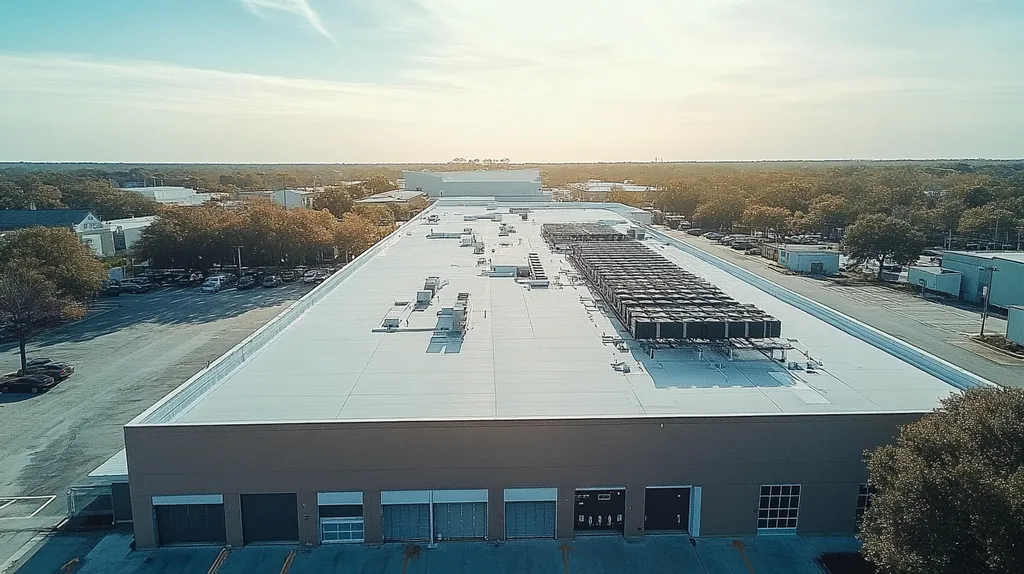Commercial roof penetrations represent the most vulnerable points in any roofing system, with industry data showing that 80% of all roof leaks originate at these critical junctions. For facility managers, the stakes couldn’t be higher – a single compromised penetration can result in thousands of dollars in water damage and disrupted operations.
This systematic analysis examines the key factors in evaluating commercial roof penetrations, from performance metrics to compliance requirements. Understanding these elements is crucial for protecting valuable assets and maintaining building integrity.
By focusing on six core areas – performance, finances, compliance, risk management, operations, and long-term planning – facility managers can develop a comprehensive approach to managing these essential roofing components.
SECTION 1: PERFORMANCE FACTORS
Commercial roof penetrations represent one of the most vulnerable sections of a roofing system, often serving as gateways for leaks that can wreak havoc on a building. Research indicates that a staggering 80% of roof leaks can be traced back to these penetrations. With repair costs potentially soaring into the thousands and the risk of operational downtime, paying close attention to the quality of these areas is critical. Facility managers must grasp the essential performance factors to reduce vulnerabilities. This section covers sealing integrity, moisture intrusion detection, and structural impact assessments.
Roof Penetration Sealing Integrity
Sealing integrity around roof penetrations is paramount in thwarting leaks. Inadequately sealed areas can let water seep in, resulting in damage to both the roofing materials and the building’s interior. Facility managers should conduct regular inspections to identify any signs of wear or degradation in the seals.
Common sealing materials, such as caulking, flashing, and membranes, require proper upkeep. For example, EPDM and TPO membranes are susceptible to degradation from UV radiation over time. Regular maintenance checks and timely repairs are essential to keep these seals functioning effectively.
Employing the correct sealing techniques for each type of penetration is also crucial, whether for HVAC units or plumbing stacks. Using improper methods can significantly undermine the roof’s overall performance.
Key Action Items
Moisture Intrusion Detection
Early detection of moisture intrusion is vital for maintaining building integrity. Water infiltrating through penetrations can lead to mold growth, structural issues, and inflated energy bills. Implementing moisture detection systems provides facility managers with crucial early warnings about hidden leaks.
Infrared thermography is an effective method for detecting temperature fluctuations that may indicate moisture presence. This non-invasive approach allows for problem identification without disrupting roofing materials. It’s beneficial to incorporate regular thermal imaging assessments into a comprehensive roofing maintenance strategy.
Visual inspections also play a crucial role in identifying moisture-related problems. Facility managers should train staff to spot red flags, such as water stains or ceiling blistering. Promptly addressing these issues can prevent more extensive damage and costly repairs.
Key Action Items
Structural Impact Assessment
Understanding how roof penetrations affect structural integrity is essential for ensuring long-term stability. Each penetration alters load distribution on the roof, potentially creating weak spots. Regular evaluations are necessary to assess whether these changes compromise the roof’s overall strength.
Facility managers must consider the impact of mechanical systems and piping on the roof’s structure. Excessive weight from equipment can lead to sagging or even structural failure over time. Performing load calculations helps determine safe positioning and supports effective management of roof penetrations.
Moreover, using materials that are compatible with existing roofing systems is critical. Inadequate material compatibility can intensify wear, leading to premature failures. Collaboration with structural engineers and roofing specialists enhances assessments and informs best practices for maintaining the roof’s performance and safety.
Key Action Items
SECTION 2: FINANCIAL CONSIDERATIONS
The financial implications of commercial roof penetrations can be significant, impacting budgets and overall asset value. In fact, research shows that improper installation may increase maintenance costs by up to 25%. Recognizing these costs is vital for facility managers to safeguard financial resources while ensuring a well-maintained property. This section highlights repair and maintenance expenditures, how roof condition influences insurance premiums, and the potential for extending a roof’s lifespan.
Cost of Repairs and Maintenance
Every roof penetration presents a potential leak point that, if ignored, can escalate into major repair expenses. A small, unaddressed leak can lead to not just water damage but also mold growth and degraded insulation.
Conducting regular maintenance is crucial to mitigate these risks, yet many property owners overlook the importance of ongoing assessments. For instance, routine inspections can identify early wear, averting thousands of dollars in comprehensive restorations.
By investing in preventive measures such as high-quality flashings and sealants, facility managers can offset long-term costs. Understanding the full lifecycle cost of their roofing systems is essential for effective budget management.
Key Action Items
Impact on Insurance Premiums
The condition of a roof and its maintenance history greatly influence insurance premiums. Properties with well-maintained roofs often enjoy lower premiums, signaling reduced risk to insurers. Conversely, unresolved penetration issues can trigger higher premiums or, in some cases, even lead to coverage denials.
By prioritizing preventive maintenance, facility managers can improve a property’s insurability and overall financial health. Insurers are likely to reward a proactive approach with tiered discounts.
Documenting regular inspections and repairs strengthens a facility manager’s position during annual premium negotiations, highlighting the organization’s commitment to mitigating risk.
Key Action Items
Potential for Extended Roof Lifespan
Effectively managing roof penetrations can lead to a significantly extended lifespan for a commercial roof. When issues are identified and resolved promptly, the materials remain safeguarded against water damage and environmental wear.
A roof that benefits from timely maintenance can serve for 20 years or more, while those neglected may require replacement within a decade. This longevity directly reduces long-term capital expenditures for facility managers.
Furthermore, a well-maintained roof contributes to a facility’s overall value. Investors view these properties as lower risk, which can enhance potential resale opportunities. Attention to roof penetration management ensures assets remain competitive in the market.
Key Action Items
SECTION 3: COMPLIANCE REQUIREMENTS
Compliance with regulations surrounding roof penetrations is not just a formality; it is a crucial element in safeguarding against leaks, structural damage, and serious safety risks. Alarmingly, nearly 20% of commercial roofing failures arise from improper installation around these vital areas. To prevent costly repercussions, facility managers must remain diligent in adhering to building codes, following manufacturer installation guidelines, and understanding regulatory standards. Each aspect of compliance is essential for ensuring the longevity and effectiveness of the roofing system.
Adherence to Building Codes
Building codes are implemented to guarantee safety, structural stability, and fire protection in commercial properties. These codes dictate how roof penetrations must be installed to minimize risks and prevent water intrusion. For example, specific requirements may mandate proper flashing and sealing materials around vents and chimneys to provide effective waterproofing.
Non-compliance with building codes can have significant consequences, including financial penalties, legal issues, and increased insurance rates. In addition, ignoring these regulations can expose properties to unpredictable weather impacts, leading to unexpected repair needs. Facility managers should stay informed about local building codes to ensure that all penetrations are compliant and adequately protected.
Regular inspections facilitate proactive identification of areas needing upgrades or repairs. Collaborating with experienced roofing contractors can simplify the process of ensuring compliance and minimizing risks. Following these regulations not only secures the building but can also enhance its overall market value.
Key Action Items
Manufacturer Installation Guidelines
Each roofing system includes specific installation guidelines provided by manufacturers. These guidelines are founded on extensive research and play a critical role in ensuring peak performance. For penetrations, manufacturers typically outline the required materials and techniques necessary for achieving a watertight seal.
When installation teams deviate from these specified guidelines, the risk of roofing failure dramatically increases. For instance, using an inappropriate sealant can compromise adhesion, leading to the onset of leaks. Facility managers should be vigilant in enforcing adherence to these guidelines to align with the specialized needs of each roofing system.
Moreover, warranties from manufacturers often hinge on compliance with installation instructions. If these stipulations are ignored, it could result in the nullification of warranties, incurring significant financial repercussions. Regular communication with contractors reinforces the importance of following these guidelines, ensuring the roofing system maintains its integrity over its entire lifespan.
Key Action Items
Regulatory Standards for Penetrations
Regulatory standards govern the management of roof penetrations to ensure safety and reliability. These standards address various issues, including structural performance and fire safety. For instance, codes from the National Fire Protection Association (NFPA) dictate acceptable materials and methods for roof penetrations to mitigate fire risks.
Additionally, environmental regulations often stipulate how mechanical systems should vent or drain through roofs. Facility managers must stay aware of these requirements to avert potential violations and penalties. Non-compliance can lead to operational disruptions and hefty costs associated with retrofitting or corrective actions.
Ignoring regulatory standards can also affect insurance coverage and financing options. Insurers frequently require proof of compliance as part of coverage agreements. Therefore, remaining current with these standards is not only responsible but essential for securing the facility’s operational stability.
Key Action Items
SECTION 4: RISK MANAGEMENT
Effective risk management regarding roof penetrations is crucial for facility managers, as failures can lead to substantial water damage and liability problems. Research shows that up to 90% of roof leaks originate from penetrations. Without proactive evaluations, these vulnerabilities can lead to expensive repairs and interruptions to business operations. This section explores the primary risks tied to roof penetrations, focusing on potential leaks, safety hazards, and their implications for liability and insurance.
Leak and Water Damage Risks
Leakage poses a significant challenge with roof penetrations. When not properly addressed, these areas can compromise the roofing system, resulting in water intrusion and potential structural damage. Studies show that the fallout from water damage can lead to repairs exceeding thousands of dollars if left unchecked.
Materials around penetrations, such as flashing and sealants, are prone to deterioration. Regular inspections can help spot wear and tear before it escalates into leaks. Implementing a preventive maintenance schedule keeps facility managers proactive in managing potential issues.
The repercussions of water damage extend beyond immediate repair costs. They include reduced asset value, possible mold growth, and disruptions to business activities, which can adversely affect a company’s financial health. Vigilance in maintaining roof penetrations is essential to mitigate these risks effectively.
Key Action Items
Safety Hazards Around Penetrations
Safety concerns are paramount when it comes to roof penetrations. Poorly maintained areas can pose risks for maintenance personnel. Common issues include injuries resulting from loose or damaged equipment around these critical zones.
Accidents may stem from falls, slips, and trips caused by insufficient safety barriers or inadequate access routes. Conducting comprehensive risk assessments can help identify and address these dangers, thereby enhancing overall workplace safety.
Additionally, hazardous materials located near penetrations could expose workers to health risks. Regular safety inspections should focus on visible hazards and ensure that adequate safety measures are implemented throughout the facility.
Key Action Items
Liability and Insurance Implications
Liability issues can arise when roof penetrations lead to leaks or injuries. Facility managers must recognize that failing to maintain these areas can expose them to lawsuits and insurance claims. Insurers often scrutinize maintenance records when reviewing claims.
A comprehensive maintenance plan that includes periodic checks and timely repairs can strengthen a facility’s defense against liability claims. This also demonstrates due diligence in managing the property.
Moreover, ensuring there is adequate insurance coverage for roof penetrations can help reduce financial risks. Facility managers should interact with insurance providers to fully understand coverage implications associated with roofing systems.
Key Action Items
SECTION 5: OPERATIONAL PROCEDURES
Efficient management of roof penetrations is vital to minimize leaks and extend the life of roofing systems. Regular inspections, precise documentation, and prompt emergency responses can significantly lower repair costs and protect building interiors. With the potential for water damage averaging $30,000 per incident, facility managers must implement systematic operational procedures to combat these risks.
Regular Inspection Schedules
Establishing a routine inspection schedule is critical for maintaining the integrity of roof penetrations. Ideally, inspections should be conducted at least twice a year, particularly in spring and fall. These inspections should focus on identifying signs of wear, corrosion or damage around high-risk areas such as vents, pipes, and HVAC units.
Early detection can prevent minor issues, like cracked flashing, from escalating into major leaks. To enhance thoroughness, facility managers should use an inspection checklist to ensure all aspects, including sealant integrity and flashing condition, are covered.
Documenting findings during inspections is equally important, as this historical data aids in evaluating the condition of penetrations over time. Utilizing this information can help inform future maintenance decisions and budget allocations.
Key Action Items
Documentation and Reporting
Keeping detailed documentation is essential for tracking the condition of roof penetrations over time. Facility managers should maintain a central digital repository for inspection reports, photographs, and repair logs, which fosters efficient communication with roofing professionals and internal teams.
Documentation should capture inspection dates, findings, and corrective measures taken, thereby allowing for a clearer overview of the roof’s condition. Regular updates help teams assess ongoing repair effectiveness and discern patterns in wear or issues.
Creating visual aids, such as graphs showing repair history, can enhance understanding among stakeholders about urgency and future maintenance needs. Clear reporting promotes accountability among team members, ensuring everyone understands their responsibilities.
Key Action Items
Emergency Response Protocols
A well-defined emergency response protocol is crucial for addressing unforeseen leaks or failures around roof penetrations. Facility managers should establish a rapid response team, including roofing professionals and facility personnel, to act quickly in emergencies.
Emergency plans must outline procedures for identifying leaks, assessing damage, and implementing immediate repairs. For instance, using tarps to temporarily cover breached areas can prevent further damage until comprehensive repairs are conducted. Keeping a list of qualified roofing contractors on hand improves response times.
Training staff on emergency protocols is essential to ensure everyone understands their roles during a crisis. Regular drills help reinforce these procedures, ensuring readiness in real situations. Documenting response actions and their outcomes will help refine future protocols and enhance overall facility safety.
Key Action Items
SECTION 5: OPERATIONAL PROCEDURES
Effective management of roof penetrations is essential for minimizing leaks and extending the lifespan of roofing systems. Regular inspections, thorough documentation, and swift emergency responses can drastically lower repair costs and safeguard building interiors. Data shows that leaks from inadequately maintained penetrations can result in an average of $30,000 in water damage per incident. With this in mind, facility managers must implement systematic operational procedures to tackle these challenges head-on.
Regular Inspection Schedules
Establishing a routine inspection schedule is vital for maintaining the integrity of roof penetrations. Experts recommend conducting inspections at least twice a year, ideally in spring and fall. These inspections should focus on identifying signs of wear, corrosion, or damage around critical areas such as vents, pipes, and HVAC units.
By planning comprehensive inspections, facility managers can catch minor issues early before they escalate into significant leaks. For instance, a small crack in flashing can lead to extensive interior damage if not addressed promptly.
Using a detailed checklist during inspections ensures that all essential aspects are covered, including sealant integrity, flashing condition, and the alignment of roofing materials around penetrations. Documenting findings is also crucial for tracking the condition of penetrations over time and informing future maintenance needs.
Key Action Items
Documentation and Reporting
Maintaining detailed documentation is critical for effective tracking of roof penetration conditions over time. Facility managers should establish a centralized database where all inspection reports, photographs, and repair logs can be stored. This practice enhances communication with roofing professionals and internal teams.
Inspection reports should capture vital information, such as dates, findings, and any corrective actions taken. By regularly updating this data, teams can monitor repair effectiveness and detect wear trends, which can be instrumental in managing the roofing system long-term.
Additionally, visual representations like graphs can help stakeholders understand the urgency of necessary maintenance and inform budgeting for upcoming capital expenditures. Clear reporting also enhances accountability, ensuring that everyone is aware of their responsibilities in roof management.
Key Action Items
Emergency Response Protocols
A clear emergency response protocol is essential for effectively handling unexpected leaks or failures around roof penetrations. Facility managers should assemble a rapid response team, which includes roofing professionals and facility staff, to promptly assess and mitigate any damage.
The emergency response plan should include established steps for leak identification, damage assessment, and immediate repair actions. For instance, using tarps can provide temporary protection over breached areas until permanent repairs can be made. Having a list of reliable roofing contractors ready to contact can significantly speed up response time.
Training staff in emergency procedures is vital to ensure that everyone understands their specific roles during a crisis. Regular emergency drills can cement these procedures, fostering preparedness when real incidents arise. Documenting responses and outcomes will help to improve future protocols, addressing vulnerabilities and enhancing overall facilities safety.
Key Action Items
The Bottom Line
With 80% of commercial roof leaks originating at penetrations, facility managers cannot afford to take a reactive approach to these critical components.
The systematic evaluation of roof penetrations requires vigilance across multiple domains: performance monitoring, financial planning, compliance verification, risk management, and operational procedures.
By implementing regular inspection schedules, maintaining detailed documentation, and establishing clear emergency protocols, organizations can prevent costly water damage that averages $30,000 per incident.
As building systems become more complex and regulatory requirements more stringent, a proactive strategy for managing roof penetrations isn’t just good practice – it’s essential for protecting valuable assets and maintaining operational continuity.
The future of effective facility management depends on treating roof penetrations as the critical building components they truly are.
FREQUENTLY ASKED QUESTIONS
Q. What performance factors should I consider for my commercial roof?
A. Key performance factors include sealing integrity, moisture detection, and structural assessments. Regular inspections are vital to identify wear or degradation that can lead to leaks, protecting both the roof and the building’s interior.
Q. How do commercial roof penetrations affect my maintenance budget?
A. Roof penetrations can significantly impact maintenance costs. Addressing issues promptly through regular inspections can prevent expensive repairs and extend the roof’s lifespan, ultimately helping you manage your budget effectively.
Q. What compliance requirements should I follow for my industrial roof?
A. Compliance with local building codes, manufacturer guidelines, and regulatory standards is essential. Adhering to these requirements safeguards against leaks and structural damage, while also protecting your investment in the property.
Q. What risks are associated with commercial roof penetrations?
A. The main risks include leaks, water damage, and safety hazards. Neglecting maintenance increases these risks, which can lead to costly repairs, operational disruptions, and liability issues for facility managers.
Q. How often should I inspect roof penetrations on my commercial property?
A. It’s recommended to inspect roof penetrations at least twice a year, particularly in spring and fall. Regular inspections help identify signs of wear or damage early and can prevent leaks before they escalate.
Q. What documentation should I keep for my commercial roof?
A. Maintain a detailed record of inspections, repairs, and any observations related to roof penetrations. This documentation is crucial for tracking the roof’s condition and can support compliance and insurance needs.
Q. How can I prepare for emergencies involving my industrial roof?
A. Establish an emergency response protocol that includes rapid assessment procedures and temporary repair solutions. Training staff and having a directory of roofing contractors ready can enhance your preparedness for unexpected leaks.


